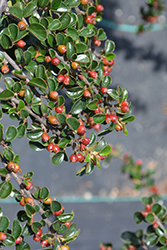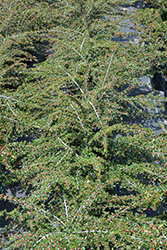It's all about ...
plants

Ladder Leaf Cotoneaster
Cotoneaster 'Ladder Leaf'
Height: 24 inches
Spread: 5 feet
Sunlight:
![]()
![]()
Hardiness Zone: 7b
Other Names: Bearberry Cotoneaster Hybrid
Description:
An excellent low spreading groundcover, featuring pinkish-white flowers in spring, followed by small orange-red berries; rounded evergreen leaves require adequate snow cover or protection from winter sun and wind in exposed locations
Ornamental Features
Ladder Leaf Cotoneaster is primarily grown for its highly ornamental fruit. It features an abundance of magnificent red berries with orange overtones from late summer to early winter. It features tiny clusters of shell pink flowers with white overtones along the branches in late spring. It has dark green evergreen foliage. The small glossy round leaves turn an outstanding brick red in the fall, which persists throughout the winter. The brick red stems can be quite attractive.
Landscape Attributes
Ladder Leaf Cotoneaster is a multi-stemmed evergreen shrub with a ground-hugging habit of growth. It lends an extremely fine and delicate texture to the landscape composition which should be used to full effect.
This shrub will require occasional maintenance and upkeep, and should not require much pruning, except when necessary, such as to remove dieback. Deer don't particularly care for this plant and will usually leave it alone in favor of tastier treats. Gardeners should be aware of the following characteristic(s) that may warrant special consideration;
- Insects
Ladder Leaf Cotoneaster is recommended for the following landscape applications;
- Mass Planting
- Rock/Alpine Gardens
- General Garden Use
- Groundcover
Planting & Growing
Ladder Leaf Cotoneaster will grow to be about 24 inches tall at maturity, with a spread of 5 feet. It tends to fill out right to the ground and therefore doesn't necessarily require facer plants in front. It grows at a fast rate, and under ideal conditions can be expected to live for approximately 30 years.
This shrub does best in full sun to partial shade. It is very adaptable to both dry and moist growing conditions, but will not tolerate any standing water. This plant will benefit from an application of bonemeal and/or mycorrhizal fertilizer at the time of planting. It is not particular as to soil pH, but grows best in rich soils, and is able to handle environmental salt. It is highly tolerant of urban pollution and will even thrive in inner city environments. This particular variety is an interspecific hybrid.
This plant is not reliably hardy in our region, and certain restrictions may apply; contact the store for more information.

